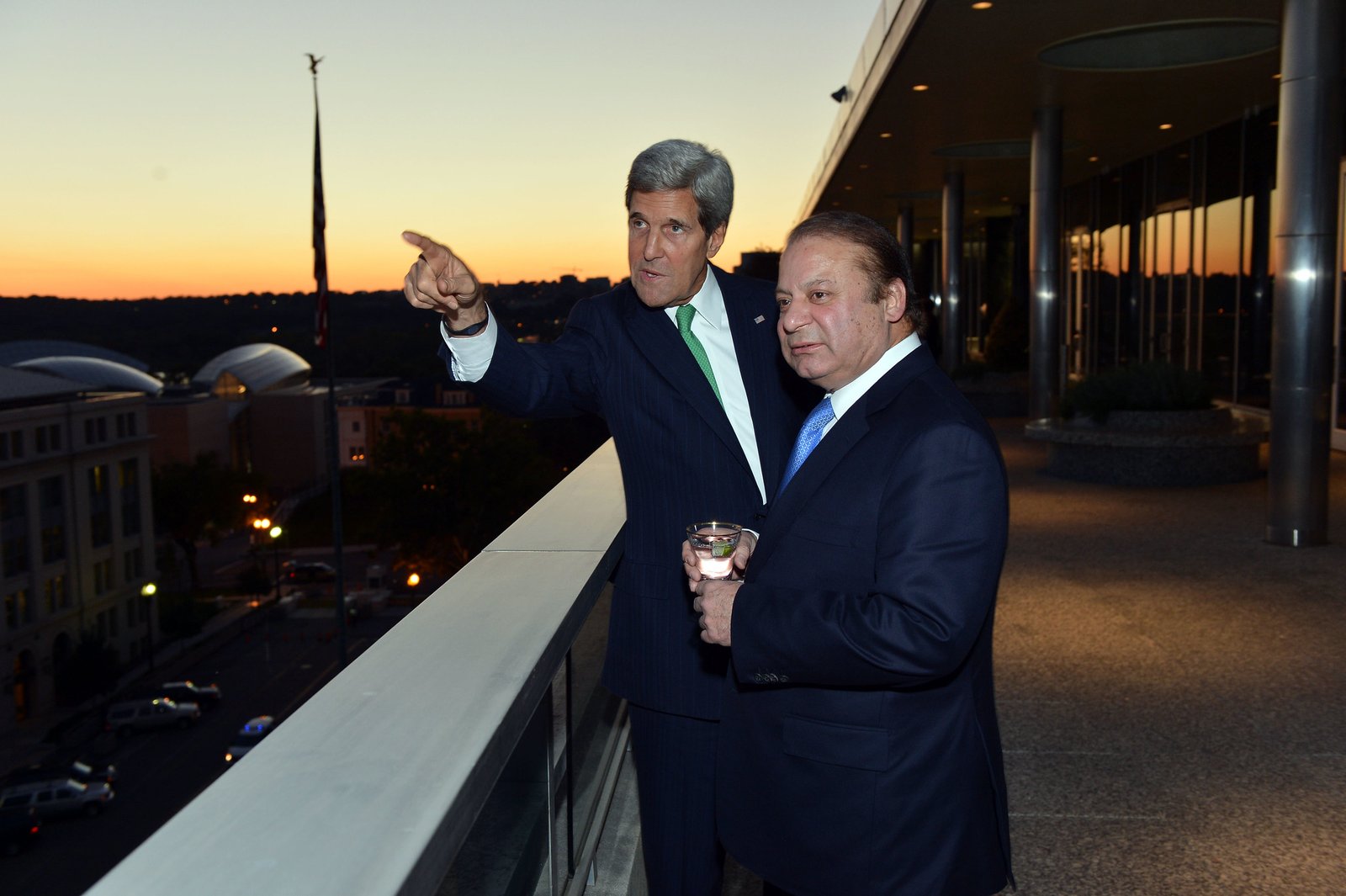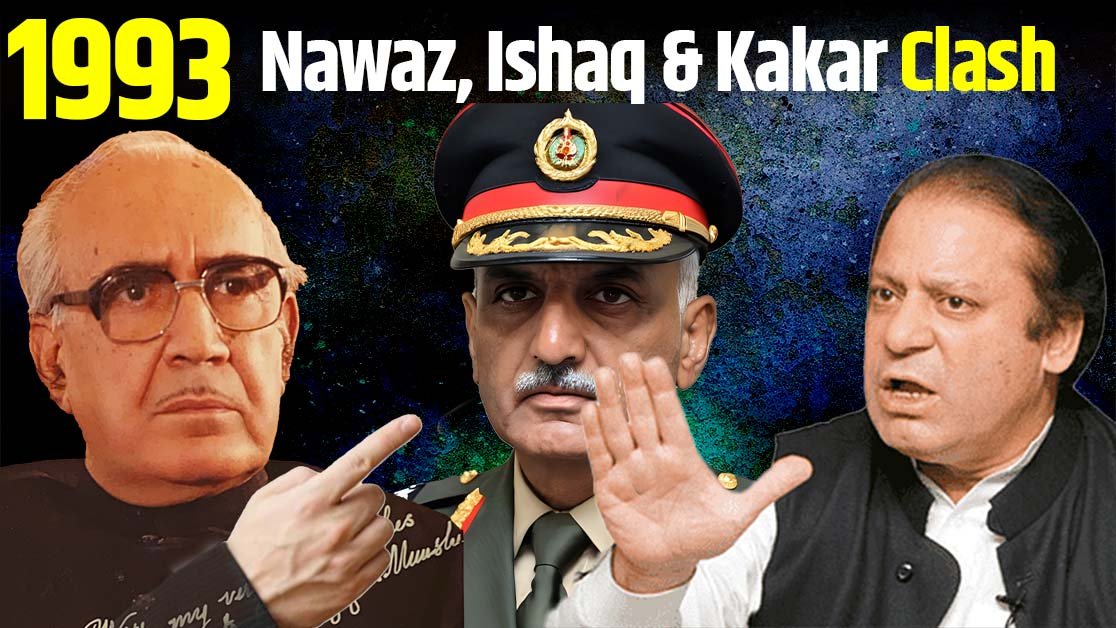Read Part-2 of Political History of Nawaz Sharif and PMLN
Nawaz’s Plea to ISI: ‘Save Us From These Two Pathans’
In 1993, right after an important meeting, Nawaz Sharif quickly grabbed the ISI chief by the arm, pulled him aside, and whispered in pure Punjabi: “Listen, don’t forget to take care of us, otherwise these two Pathans will start dominating us.”
This was during a time when Nawaz Sharif’s government was struggling in its final days. On this occasion, Army Chief General Waheed Kakar and ISI Chief General Javed Ashraf Qazi arrived at Sharif House to mediate the ongoing conflict between the President Ishaq Khan and the Prime Minister. It was here that Nawaz Sharif requested them to protect him from “two Pathans.”
The “two Pathans” Nawaz Sharif was referring to were President Ghulam Ishaq Khan and the other guest present at the spot, Army Chief General Abdul Waheed Kakar. Their discussion revolved around the ongoing political tension between the President and the Prime Minister, as well as the upcoming elections.
Ishaq Khan Appoints Pashtun Army Chief
The conflict between President Ghulam Ishaq Khan and Prime Minister Nawaz Sharif came into the open in 1993 when, after the death of Army Chief General Asif Nawaz, President Ishaq Khan appointed General Abdul Waheed Kakar, a fellow Pashtun, as the new Army Chief. This decision angered Nawaz Sharif.
It was well-known about General Abdul Waheed Kakar that he was highly skilled at trapping his prey and never let go once he had a hold. During his tenure, he removed four lieutenant generals and five or six major generals from the army.
Even though Nawaz knew that the President was strong at the time due to his constitutional powers and military backing, he openly started talking about reducing the President’s authority.
Nawaz Replaces Pro Muslims ISI Chief Under US Pressure
Meanwhile, the U.S. was concerned about the activities of ISI Chief General Javed Nasir, who was actively helping Muslims in Kashmir, Afghanistan, and Bosnia. The Army Chief expressed concerns about the ISI chief’s actions and pressured the Prime Minister to remove him quickly because America was unhappy with him—this ISI chief who saw the suffering of Muslims worldwide as Pakistan’s own suffering.
Nawaz Appoints Muhajir ISI Chief After US Pressure
In response, Prime Minister Nawaz Sharif immediately replaced General Javed Nasir and appointed General Javed Ashraf Qazi as the new ISI chief.
General Qazi was originally a Muhajir (migrant) – his family had migrated from Shimla, India to Pakistan after partition. Perhaps because of this Muhajir background, Nawaz Sharif considered him closer to his own political camp.

Opposition Backs President as Army Chief Sides with Ishaq Khan
At this juncture, the opposition now had two options: either join forces with the President to overthrow Nawaz’s government, or ally with Nawaz to restrict the President’s powers strictly within the walls of the President House. However, the opposition was carefully watching to see which side would emerge victorious in this power struggle before committing their support.
They observed that Army Chief Kakar’s sympathies lay with Ishaq Khan, which tilted the balance in the President’s favor. Consequently, the opposition decided to back the President.
Forming a united front, the opposition launched a long march against Nawaz Sharif. During this movement, Maulana Kausar Niazi made a startling claim – he alleged that America had given Nawaz Sharif the task of shutting down Pakistan’s nuclear program. According to Niazi, this was why Nawaz wanted to reduce presidential powers and take full control himself, so he could fulfill this alleged promise to America.
Niazi further cited Dr. Abdul Qadeer Khan, claiming that Dr. Qadeer had said President Ishaq Khan was protecting Pakistan’s nuclear program “like an unshakable rock.” This narrative portrayed Ishaq Khan as the guardian of Pakistan’s nuclear ambitions while casting suspicion on Nawaz Sharif’s intentions.
1993 Crisis: Ishaq Khan Dismisses Nawaz on Live TV
On the evening of April 17, 1993, Nawaz Sharif suddenly appeared on PTV and declared war against the President, stating that he would neither dissolve the assembly nor accept anyone’s dictation.
When President Ghulam Ishaq Khan, along with Army Chief Waheed Kakar and the President’s advisor Roedad Khan, heard Nawaz Sharif’s speech while sitting in Army House, the President was furious at Nawaz’s defiant tone.
Two days later, the President himself stepped out of the Presidency and arrived at the PTV building. He ordered the cameras to roll and, in a televised address to the nation, announced the dismissal of Nawaz Sharif’s government.
Nawaz’s Midnight Run to Supreme Court Saves Govt
Upon hearing this announcement, Nawaz rushed out of the Prime Minister’s House and ran straight to the gates of the Supreme Court, banging on them loudly. The Supreme Court declared the President’s decision unconstitutional and reinstated Nawaz’s government.
When the echoes of the Supreme Court’s verdict reached the nearby neighborhood of the Presidency, President Ishaq Khan faced deep humiliation. The Supreme Court now stood clearly visible between the Prime Minister’s House and the President’s House, with intense tension brewing between the two power centers. The President’s move had backfired.
However, the seasoned bureaucrat from the past knew exactly how to paralyze a government. His next moves would prove that institutional power struggles in Pakistan were far from over.
Nawaz Beats No-Trust, Targets President
Benazir Bhutto supported the President’s movement against Nawaz Sharif and had already submitted a no-confidence motion against him in the assembly.
Two days after the Supreme Court’s verdict, Nawaz managed to defeat the no-confidence vote in the assembly.
However, the bitterness between the President and the Prime Minister refused to die down. After getting his government restored by the Supreme Court and winning the no-confidence vote, Nawaz’s camp was now determined to strip the President of his powers and confine him strictly within the walls of the Presidency.
Nawaz Lost Punjab – And Nearly Faced Civil War
But Nawaz suffered a major blow when his own ally, Punjab Chief Minister Manzoor Wattoo, switched sides and pledged loyalty to Benazir Bhutto, causing Punjab to slip from Nawaz’s grip.
Now, Nawaz’s control was limited only to the federal government.
When Benazir announced her long march from Lahore to Islamabad, Punjab CM Wattoo ordered Punjab Police to provide her full security and protection. The Punjab Police escorted Benazir’s convoy all the way from Lahore to Rawalpindi.
However, as the long march reached Faizabad Interchange in Rawalpindi, a tense standoff emerged. While Punjab Police continued protecting Benazir on one side, Nawaz’s federal police and Rangers were deployed at Islamabad’s entry points with orders to stop and arrest her.
General Waheed Kakar’s Historic Decision: No Martial Law
The situation began resembling a near civil-war-like confrontation between the two forces.
At this critical juncture, Army Chief General Abdul Waheed Kakar called an urgent corps commanders’ conference. The military leadership unanimously decided that in this delicate situation, both the President and Prime Minister should be removed, and fresh elections should be held.
This tense standoff between the President, government, and opposition presented General Kakar with a golden opportunity to send everyone home and assume power himself. However, General Kakar proved to be a true professional soldier who resisted the temptation to impose martial law.
Nawaz’s Last Gambit: A Power-Sharing Offer
Accompanied by ISI chief General Javed Ashraf Qazi and 10 Corps Commander General Ghulam Muhammad (father of future ISI chief General Asim Munir who would take office in 2024), General Kakar arrived at Sharif House for decisive talks.
During the meeting, Nawaz Sharif made a tempting offer to General Kakar: “If you send the President home, you and I can jointly run the government.” General Kakar firmly rejected this proposal, responding:
“Your ongoing feud with the President is causing increasing instability in the country. Therefore, both of you must step down, go home, and prepare for fresh elections.”
This principled stand by General Kakar demonstrated remarkable restraint and commitment to democratic norms, avoiding military intervention despite having all the opportunity and justification to take over. His decision to force both feuding leaders out rather than side with either established an important precedent in Pakistan’s political history.
As the three military leaders were leaving the meeting, Nawaz Sharif suddenly grabbed ISI Chief General Qazi’s arm and whispered urgently:
“Don’t forget to protect our interests – these two Pathans (Ishaq Khan and General Kakar) are trying to dominate us.”
General Qazi calmly reassured Nawaz: “Nothing will go wrong. Just step down from government and prepare for the next elections.”
The Army Chief, who had no political ambitions, had now effectively become the kingmaker.
Room of Rage: Nawaz vs. Ishaq’s Explosive Confrontation
Later, General Kakar, ISI Chief Qazi, and Commander 10th Corps GM arranged a face-to-face meeting between Prime Minister Nawaz and President Ishaq Khan to resolve matters.
At the start, President Ishaq Khan declared:
“This meeting is incomplete without opposition leader Benazir Bhutto – she should be called.”
Nawaz retorted sarcastically:
“Why do we need the opposition leader when you’re here? You’ve become the biggest opposition leader yourself!”
This provoked Ishaq Khan, who snapped back:
“No! I’m the President of Pakistan, not the opposition leader!”
Seeing tensions escalate, General Kakar intervened firmly:
“Are you two going to reconcile or not?”
This only reignited the argument. President Ishaq pointed at Nawaz:
“This man isn’t ready for compromise!”
Nawaz immediately countered, pointing back:
“No! Actually, this man isn’t ready for compromise!”
As the meeting degenerated into another round of finger-pointing and heated exchanges, General Kakar finally made a decisive intervention:
“If this is how you both behave, then you must both go home. We will hold fresh elections. I give my word – they will be clean, transparent, and fair.”
This ultimatum marked the end of the bitter power struggle, with the military establishment stepping in as neutral arbiters to break the political deadlock between Pakistan’s two most powerful civilian leaders.
Assemblies Dissolved, President Ishaq’s Speech Lost on PTV
On the evening of July 18, 1993, at exactly 10:30 PM, Nawaz Sharif appeared on PTV and announced the dissolution of the assemblies. According to the prearranged plan, President Ghulam Ishaq Khan was scheduled to address the nation immediately afterward. However, his pre-recorded speech mysteriously vanished from PTV’s recording center – or perhaps was deliberately made to disappear.
This development left President Ishaq Khan furious, and he immediately summoned the ISI chief to lodge his final complaint. ISI Director General Javed Ashraf Qazi promptly dispatched his team to PTV headquarters with instructions to locate and broadcast the President’s missing recorded address.
Within minutes, ISI officers successfully recovered President Ishaq Khan’s speech from the personal cupboard of PTV’s chairman. At 2 AM, when the entire nation was asleep, Ishaq Khan’s final message to the nation was finally aired on PTV.
Overnight Preparations for Caretaker PM Moin Qureshi
Simultaneously, interviews for suitable candidates for the caretaker government began with great enthusiasm.
For the position of caretaker Prime Minister, Moin Qureshi, a Pakistani-origin banker based in Singapore and a cancer patient, was invited.
Overnight, his Pakistani identity card was prepared. His brother Bilal Qureshi’s measurements were taken to stitch Moin Qureshi’s sherwani (traditional formal attire), and as soon as he landed in Islamabad, he was dressed in the Prime Minister’s sherwani right at the airport.
During his tenure, Moin Qureshi released a list of loan-defaulting politicians, most of whom belonged to Nawaz Sharif’s party.
1993 Elections: Benazir Returns to Power
October 06, 1993, when general elections were being held in the country, the DG ISI went to PC Hotel in Bhurban to listen to Nusrat Fateh Ali Khan’s live qawwali performance.
When the election results came in, out of a total of 217 seats, Benazir won 86 seats while Nawaz secured 77.
Benazir succeeded in forming a government with the support of coalition partners and appointed Farooq Leghari as President.
Nawaz went into opposition. During this time, corruption charges were filed against the Sharif family. Fearing legal cases, Shahbaz Sharif fled to London, while their father, Mian Sharif, was arrested and sent to jail.
Clash Between Benazir and President Leghari
Meanwhile, Benazir Bhutto’s relationship with her own President Farooq Leghari began deteriorating. Seeing this situation, Nawaz Sharif along with his allies Chaudhry Nisar and Abida Hussain approached Farooq Leghari and provoked him to use his presidential powers to dismiss Benazir’s government.
This was exactly the same tactic Benazir had used in 1993 when she supported President Ghulam Ishaq Khan to overthrow Nawaz’s government.
Going further back, Nawaz had done something similar in 1990 when he fully supported President Ishaq Khan to remove Benazir’s government.
On November 5, 1996, Leghari dismissed Benazir’s government by leveling corruption charges against her.
When elections were held on February 3, 1997, Nawaz Sharif won a massive victory with 137 seats.
His rival PPP, already disgraced nationwide due to corruption allegations, managed to secure only 18 seats.
Nawaz Sharif was once again in the Prime Minister’s seat, and once again began locking horns with his Army Chiefs – first with General Jehangir Karamat and then with General Pervez Musharraf, who ruthlessly overthrew Nawaz’s government.
During this same period, Nawaz also achieved major milestones in Pakistan’s history, such as building motorways and conducting nuclear tests.
Then came the Kargil War, and finally in October 1999, he lost power in a military coup. All these interesting events will be covered in the next installment.
The link is given below.
Read Part-4 of Political History of Nawaz Sharif and PMLN
Read Part-1 of Political History of Nawaz Sharif and PMLN
Read Part-2 of Political History of Nawaz Sharif and PMLN
Read about Imran Khan and History of PTI
Referrences
1. Hassan Abbas, Pakistan’s Drift into Extremism.
2. Ayesha Jalal, The Struggle for Pakistan
3. Shuja Nawaz, Crossed Swords: Pakistan, its Army, and the Wars Within
4. Rosita Armytage, Big Capital in an Unequal World
5. Ian Talbot, Pakistan A Modern History
6. Sartaj Aziz, Between Dreams and Realities Some Milestones in Pakistan’s History


3 thoughts on “Nawaz Sharif vs. Ishaq Khan: How General Waheed Kakar Forced Both to Resign in 1993 – And Avoids Martial Law (Part 3)”